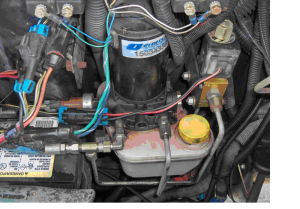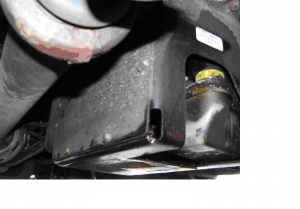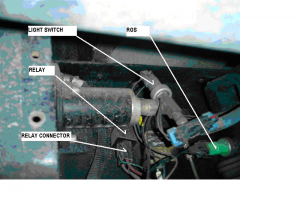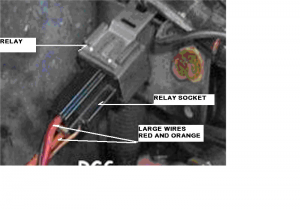AutoPark parking brake pump motor relay locating, troubleshooting and testing
Caveat: Working with “live” circuits will most always involve the possibility of screwing up something. IF you feel you are an electronic klutz, you may want to get help with these problems – – a professional, or at least a friend who has experience in these areas.
On the Version II and Version III AutoPark systems, there is a relay in the circuit whose job it is to carry the rather high current drawn by the pump motor. While not all of the systems use the same part number for the relay, in every case of which we are aware, it is a pretty garden-variety sort of automotive component. The same relays are commonly used for air conditioning clutches, headlights, horns, etc., and can be had for as little as four bucks. Most generally, they will have a part number on them, the voltage and current specs, and sometimes even a little circuit diagram printed on the side..
Below is a picture of a typical relay. Your part number may differ.
Click on image to enlarge
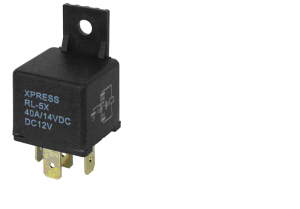 These relays do tend to toast – – over time. Especially if the system has taken the punishment most commonly occasioned by failure of the RGS (Rotten Green Switch). When the RGS shorts “ON,” the relay may be subject to long periods of operation which are bound to deteriorate the contacts under heavy current load. Under normal operation of the system, the pump will run for only a few seconds when the gear shift lever is moved out of PARK, or (in the case of the Version III system) when the yellow knob on the dashboard is pushed IN.
These relays do tend to toast – – over time. Especially if the system has taken the punishment most commonly occasioned by failure of the RGS (Rotten Green Switch). When the RGS shorts “ON,” the relay may be subject to long periods of operation which are bound to deteriorate the contacts under heavy current load. Under normal operation of the system, the pump will run for only a few seconds when the gear shift lever is moved out of PARK, or (in the case of the Version III system) when the yellow knob on the dashboard is pushed IN.
So – – If your motor does not run at all, we have several suspects:
1. The motor could be bad. VERY unlikely. We only know of ONE legitimate motor failure and replacement in all of the AutoPark issues we have dealt with. In that case, the motor really burned up – – toasted the insulation right off of the large wires feeding the motor.
We DO know of several cases where some dumb service outlet has replaced a motor in the process of throwing parts at a problem they didn’t understand. The motors were OK in many of the cases, and in others needed only the replacement of a 10 buck part.
Basically though, the pumps and motors from Parker/Oildyne, are just about bulletproof. There are a few pumps out there made by MTE – – They look quite different from the Oildyne, so are pretty easily identified by comparing pictures. In our opinion, they may not be quite as well built or as dependable as the Oildyne, but seem to get the job done most of the time.
Here is a Parker/Oildyne pump picture below – – This is in a Version III system, but the Version II pump looks the same – – adjacent components differ some from the Version II:
Click on image to enlarge
2. It is remotely possible that the large fusible link (60 amps or so) that protects the relay and motor, could be blown. We’ve never seen this happen as yet, but it has to be considered. One could test for this quite easily, by pulling the connector off of the relay, and checking for the presence of 12 volts on one of the two large wires in the female connector. The circuits show this link to be directly connected to the battery with no disconnects. If true, one of the two large wires going to the relay will be hot – – whether or not ignition is ON.
3. There is always the possibility that the holding coil in the relay is NOT being energized. It MUST see 12 volts from the control circuit to close the relay and run the motor. Checking for voltage between the two terminals on the relay connector that are fed with the smaller wires running to the connector, will determine the presence, or absence of voltage to power the holding coil. If 12 volts is NOT present (test with ignition ON, don’t start engine, move shift lever to NEUTRAL, if there is a yellow knob, it must be pushed IN), then there is probably a malfunction SOMEWHERE in the control circuit.
Difficulties with the control circuit, are not the focus of this particular writeup. The purpose here, is to either identify, or absolve the relay as the reason the pump does not run.
If for some reason you are not comfortable with making the above tests, or perhaps lack the appropriate tools, a good alternative may be to simply identify the relay, remove it, and go purchase another one. Try the new one and see if it works. Worst case, you have a spare (good thing) and at a very modest investment.
LOCATING THE RELAY:
In the Version II systems (circa 94 threw 2000), the relay is located in the AutoPark Goodie Box. Under the coach, passenger side, against the right-hand-frame-rail, and slightly aft of the transmission. Picture below – –
Click on image to enlarge
The picture on the left shows the goodie-box as being pretty messy – – the result of a leaking Rotten Green Switch. The cover plate must be removed to access the AutoPark components.
Click on image to enlarge
They will look similar to the picture on the left – – the pump is on the right hand side and just out of the picture.
On the Version III systems (2001 and later), the relay is usually on a pigtail hanging below the pump assembly, but sometimes it is mounted just to the right of the pump motor. The pump on these newer systems is located up in the front of the coach, under the utility hood. It will be on the driver’s side, to the right of the radiator. Some of the “house” builders manage to hide it behind wiring and other stuff – – but it is there. If you can’t easily find the relay, simply follow backwards the heavy wire going to the motor.
This wire will lead you to the relay location – – Usually within a few inches of the pump/motor.
The picture shown below is a typical relay and socket found on most AutoPark systems:
Click on image to enlarge
Now that you are armed with all the above information, here is a pretty direct test of the motor. This test is for the more capable and adventurous – – Electronic klutzes need not apply:
Remove the relay from the socket/connector. Locate the two terminals in the connector that are fed by the two LARGE wires. Make yourself a U shaped jumper with #12 or larger insulated wire (In an emergency, something like a paper clip will do – – careful though, as it may get hot and burn your fingers).
Jump the two LARGE wire fed terminals – – your motor should run. In the picture above, that would be the red and orange wires – – They may be different colors on your system though, but they WILL be the large wires. Be careful to jump ONLY those two terminals – – touching others may lead to measurable damage.
This concludes the relay and motor testing procedure. If you have determined by jumping the connector with the U shaped jumper that the motor runs, and have replaced the relay and the motor DOES NOT run, then there is a problem with the control circuit. Let us know and we’ll work thru that problem as a separate exercise.
Questions and comments are always welcome, oldusedbear
Download AutoPark pump motor relay locating and testing PDF here

